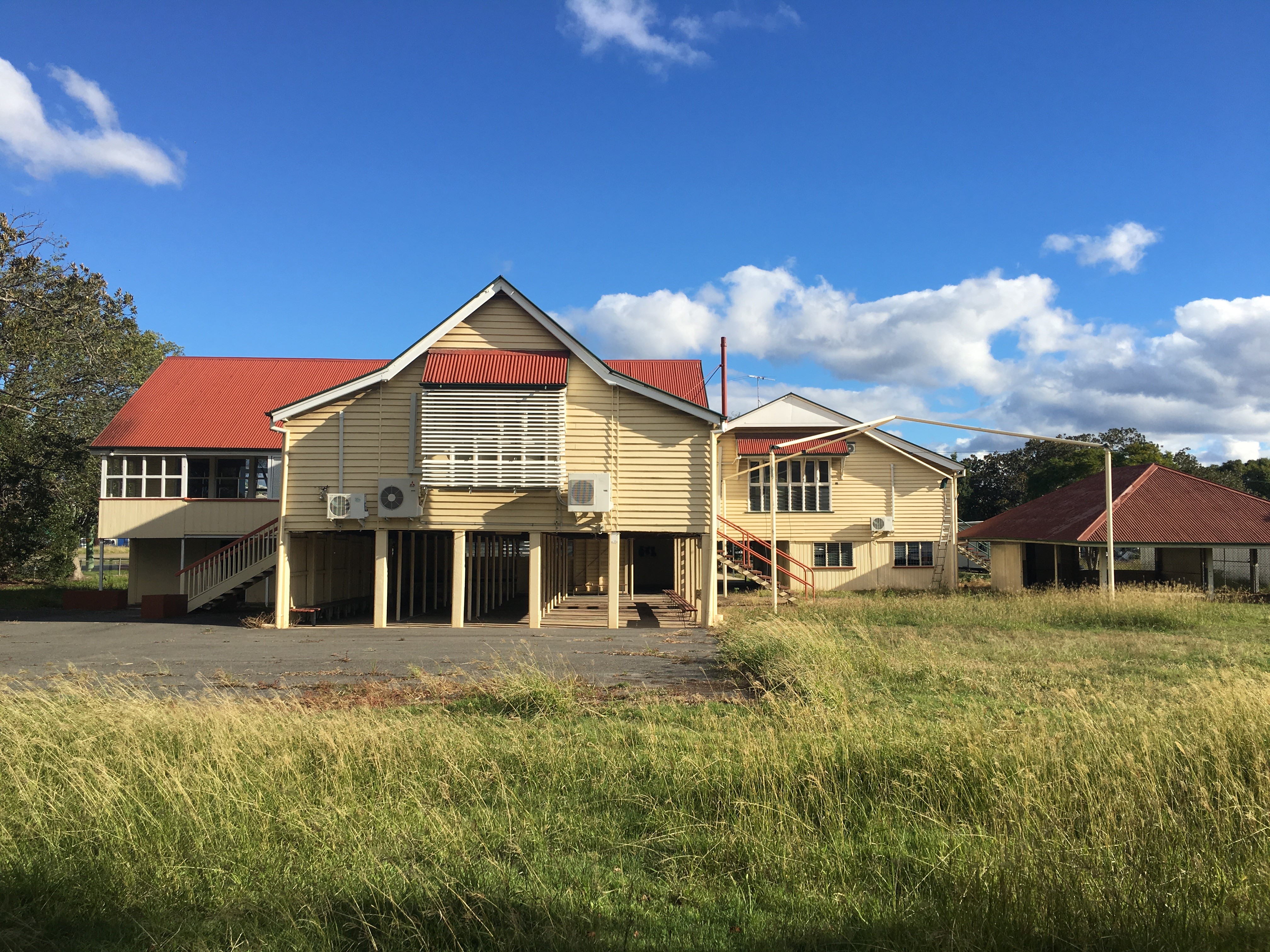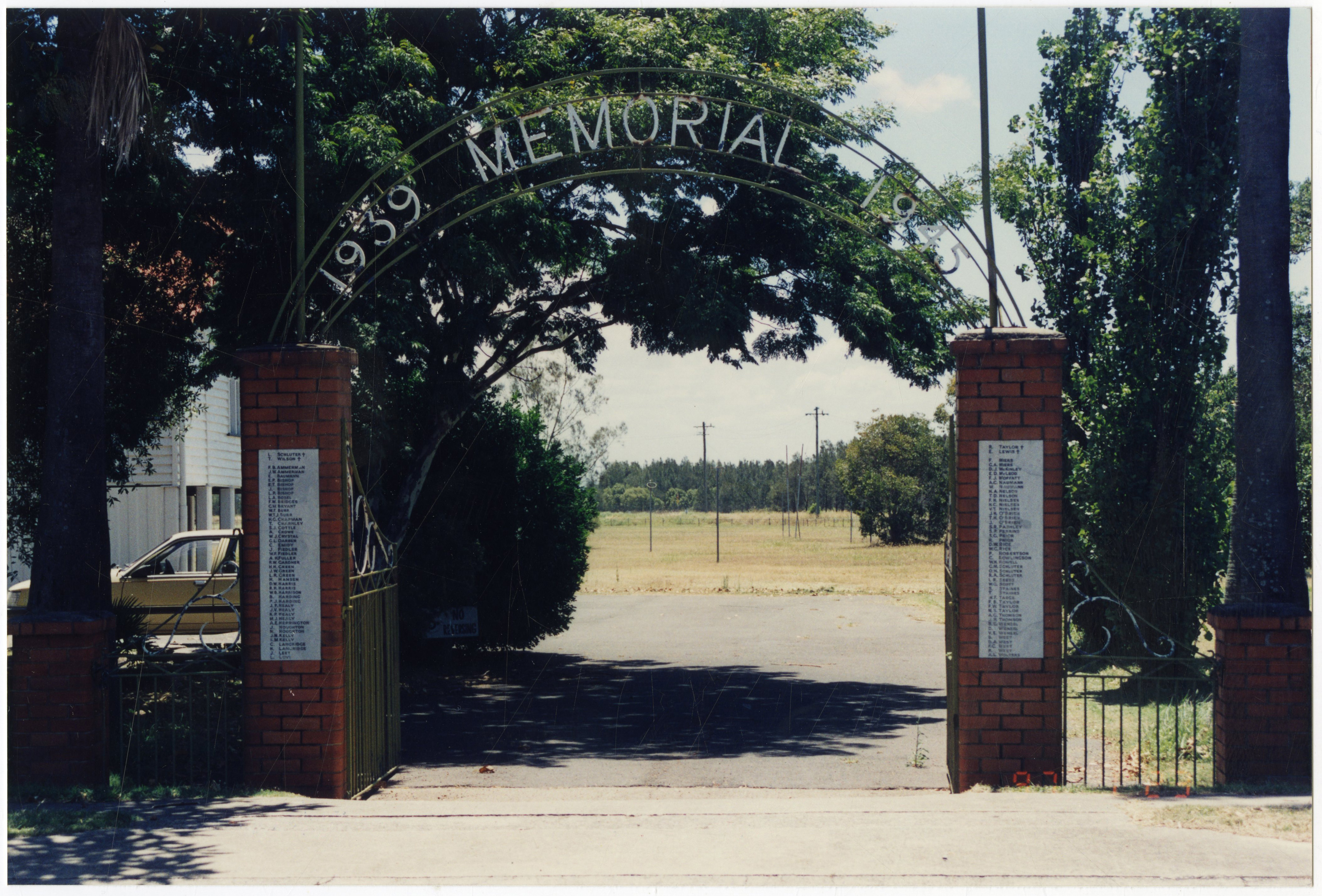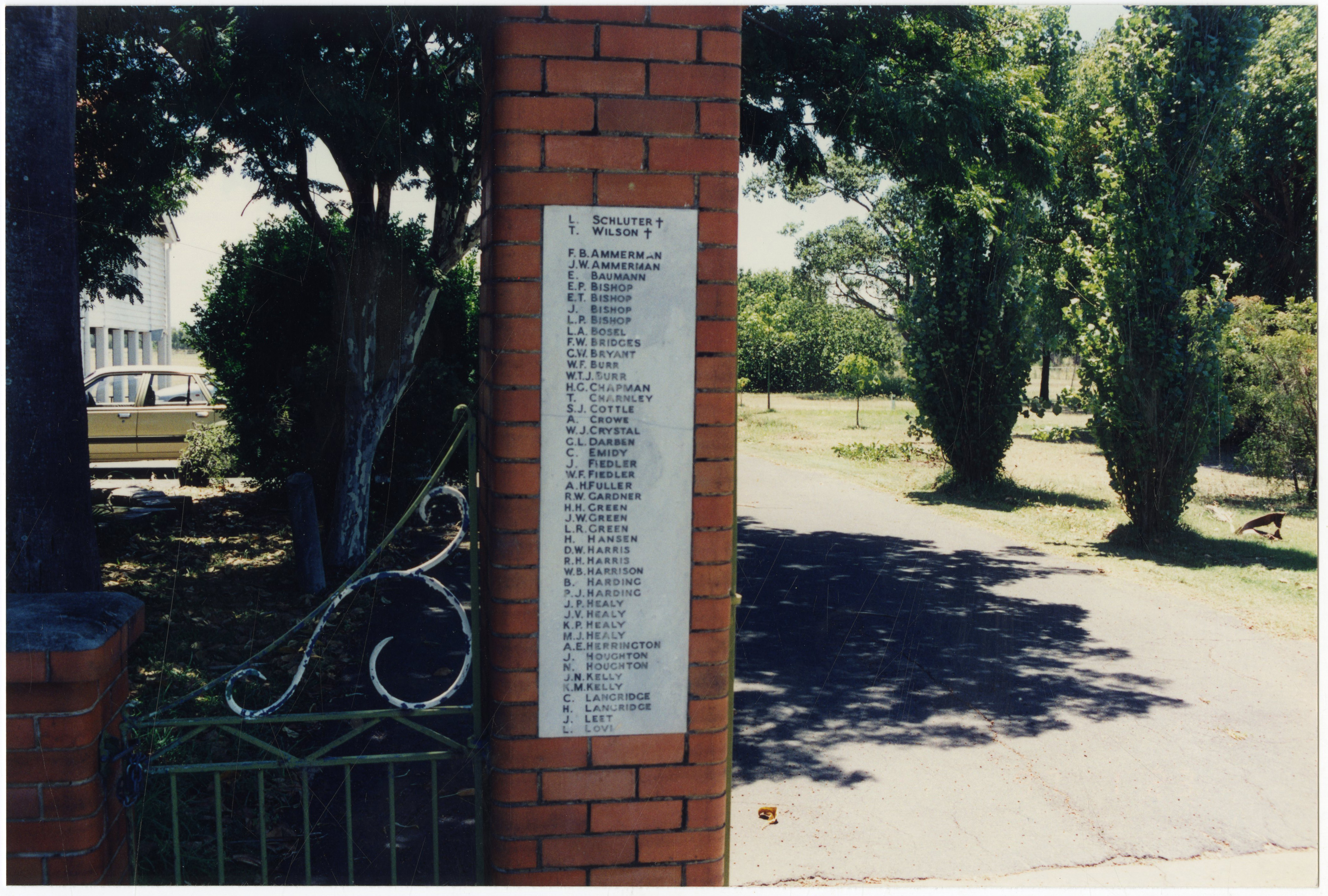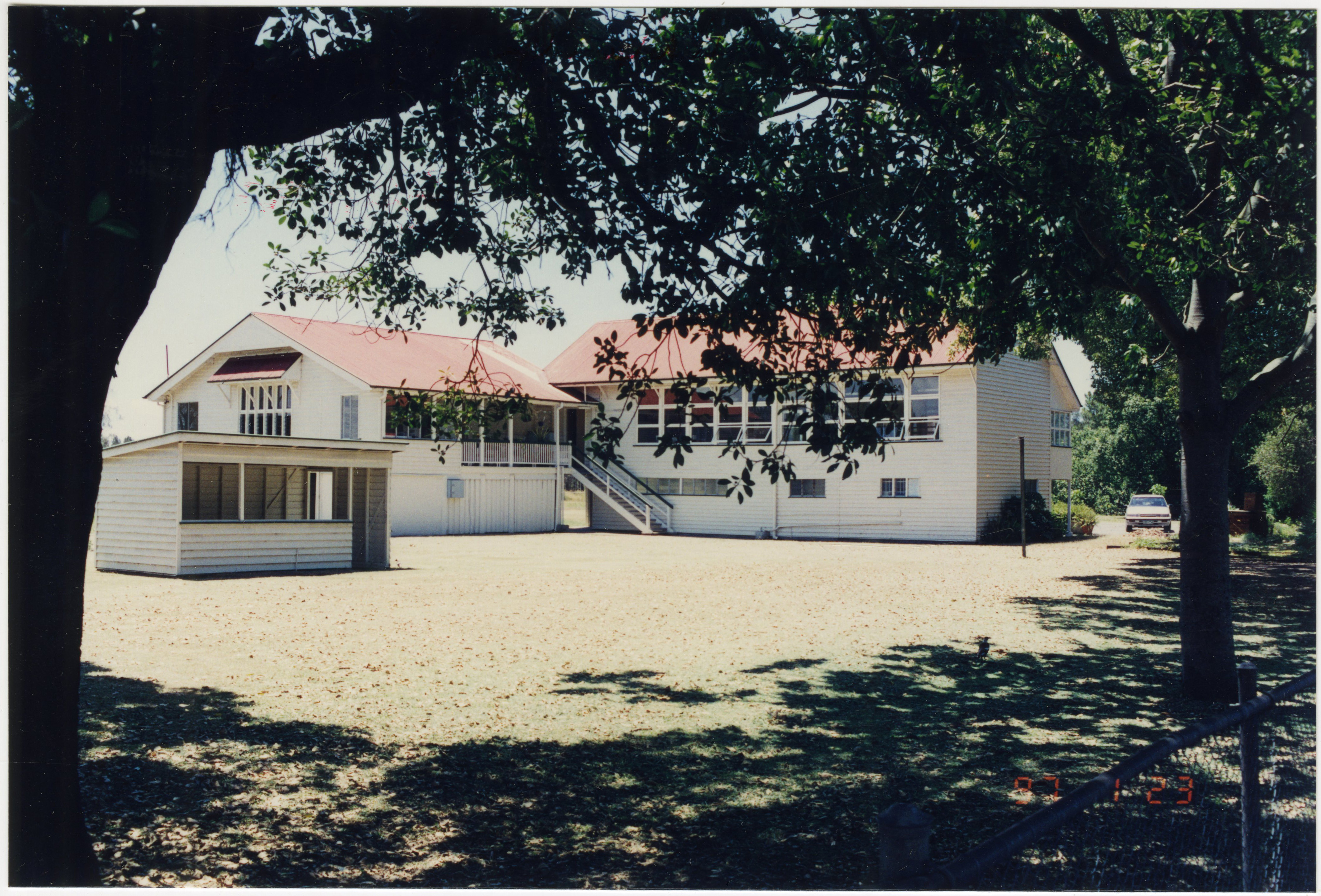Addresses
Type of place
State school
Period
Victorian 1860-1890
Style
Bungalow
Addresses
Type of place
State school
Period
Victorian 1860-1890
Style
Bungalow
The former Pinkenba State School operated from 1875 to 2008 and comprises a complex of school buildings and landscape elements built from 1875 to 1957, including a rare surviving example of an 1870s school. It was established through efforts and funds of early local residents, reflecting the local population’s early commitment to education and the new legislation for compulsory education. The original building was extended and altered over time as the local population grew and government education philosophy changed. The school includes a fine WWII memorial gate and palms on the principal thoroughfare, Eagle Farm Road. Set in extensive open playing fields and with mature Arbor Day trees, the school is a good example of a Queensland state school and demonstrates Pinkenba’s development over more than 130 years.
Lot plan
L2_SP261455; L1_SP252361
Key dates
Local Heritage Place Since —
Date of Citation —
Construction
Roof: Corrugated iron;Walls: Timber
People/associations
Ebenezer Chapman (Builder);Richard George Suter (Architect)
Criterion for listing
(A) Historical; (B) Rarity; (D) RepresentativeInteractive mapping
Lot plan
L2_SP261455; L1_SP252361
Key dates
Local Heritage Place Since —
Date of Citation —
Construction
Roof: Corrugated iron;Walls: Timber
People/associations
Ebenezer Chapman (Builder);Richard George Suter (Architect)
Criterion for listing
(A) Historical; (B) Rarity; (D) RepresentativeInteractive mapping
History
Pinkenba (initially called Boggy Creek) experienced European settlement from 1829 when it formed part of Eagle Farm, an agricultural settlement servicing the Moreton Bay penal colony. By 1830 female prisoners were recorded at Eagle Farm and within the next seven years all female prisoners had been moved there. The Moreton Bay penal colony was closed in 1838 and the Eagle Farm Female Women’s Prison was also closed. The site continued as a government owned cattle station until 1842 when the area was surveyed and auctioned for public sale.
From the 1860s Pinkenba developed as a collection of small farms. As a result of the Queensland Government’s immigration initiatives many European immigrants arrived in Queensland to begin new lives working on the land. By 1874 there were twenty-two families living in the Pinkenba area, mostly of German origin. A school had been established at Eagle Farm in 1864, but the growing Pinkenba community sought to open a school in their local area.
The establishment of schools was considered an essential step in the development of early communities and integral to their success. Locals often donated land and labour for a school's construction and the school community contributed to maintenance and development. Schools became a major community focus for social interaction, a symbol of progress and a source of pride with enduring connections formed with past pupils, parents and teachers. The inclusion of war memorials and halls used for community purposes reinforced these connections together with fetes, markets, public holiday celebrations, school break-up days, fundraisers, polling days, sporting events, reunions, and dances, all held within the schools' buildings and grounds.
The Pinkenba School Committee was formed in 1873. By July 1874 the committee had raised £100 towards the cost of a school building and teacher's residence. It petitioned the Board of General Education for a school to serve the 79 children in the district, of whom 55 were ready for school. Ten acres (4ha) of Portion 95 were donated for a school reserve by early prominent Pinkenba resident and farmer Thomas McBride. The Queensland Government approved the school’s establishment and provided standard plans for the school buildings.
From the 1860s until the 1960s, Queensland school buildings were predominantly timber framed, taking advantage of the material's abundance in the state and the high number of builders skilled in its use. This also allowed for easy and economical construction and enabled the government to provide facilities in remote areas. Due to the standardisation of facilities, schools across the state were developed in distinctly similar ways and became complexes of typical components. These components included: the teaching building/s, the school yard, the sports oval, the head teacher's residence, and a variety of landscape elements such as sporting facilities or play equipment, playsheds, gardens and trees.
The Pinkenba School was designed by respected Brisbane architect Richard George Suter and built by Ebenezer Chapman. Suter was one of a number of private architects who designed school facilities for Queensland's Government assisted schools. Suter's designs were used between 1868 and 1875. He developed a number of standard plans for rural schools comprising timber with outside studding, and including regulated furniture designs. Suter's early timber schools were lowset, rectangular in plan with a porch and no verandas. From 1874 standardised plans were used by the Board and verandas were added to the front and rear. Suter left Queensland in early 1875, although his designs continued to influence his successors.
Tenders were called by the Department of Public Instruction. Construction cost £420 12s with £112 coming from the Pinkenba community and the remainder provided by the Queensland Government. The school at Pinkenba opened on 22 February 1875 as Boggy Creek National School with 47 students. It comprised a teaching building, which was a lowset one roomed timber structure 15' 9" by 29' 7" (4.8m x 9m) with front and rear verandas 7' (2.1m) wide and a timber shingle roof. A teacher's residence was built at the same time. The grounds included a playing field and McBride’s pony paddock.
The Boggy Creek school was renamed Myrtle State School in 1888. The population of the area increased in the late nineteenth century as industry was introduced and infrastructure improved. The Queensland Meat Export Company was the first large scale industry in the area, and was the major employer in Pinkenba well into the twentieth century. The township grew as a direct result of meat workers establishing homes in the area. Additionally and importantly for the area, the Government Powder Magazine was situated at Pinkenba.
Pinkenba’s increased population saw continued student enrolments, leading the Pinkenba school committee to approach the Department of Public Instruction early in 1894 for extensions to the school. Plans were drawn up by the end of the year. During 1893 the Department of Public Works had taken over the design of public schools from contracted architects. Classroom sizes were altered, desks rearranged and verandas widened as the department trialled different designs to improve the light and ventilation of schools. The new additions to Myrtle State School reflected these changes. The extension was added to the southern wall of the original school at right angles and was clad with chamfer boards. Ventilation of the interior was improved with a Boyles roof ridge ventilator, gable end louvres venting the ceiling space, and highset windows in the gable ends. M. Doggett submitted the successful tender of £239.16s and construction was completed in September 1895.
The establishment of the school grounds included the supply of fencing materials in 1877 to enclose its eastern section for the creation of a garden for the teacher and protection of many shade trees he had planted. Ongoing beautification of the site occurred with annual Arbor Day tree plantings. Arbor Day was established in the United States in the 1870s and spread to the Australian colonies in the late 1880s. In 1889 it reached Queensland, where the day was celebrated in primary schools with games and tree plantings, the trees being donated by the Acclimatisation Society, Forestry Department or local residents. As part of Arbor Day celebrations at the then-named Myrtle school, fourteen shade trees were planted along the fence line of Eagle Farm Road in 1890 and a further six were planted in 1891. They joined three trees planted earlier by schoolmaster FP Wood. Lining the site on the road to Myrtletown, the trees formed an observable avenue along the school boundary. Two of the bunya pines planted in the nineteenth century were removed in the 1950s.
The provision of covered play areas was introduced to Queensland in the 1870s. In February 1897 tenders were called for the construction of a play shed at the school. George Want was awarded the contract for £55 7s 6d. However, when built the entire structure was sinking in the clay soil and extra sills had to be put onto all posts. The play shed was enclosed with dressed tongue and groove timber on the southern end in 1912 and used for extra teaching space while construction of a new classroom was underway.
Pinkenba Wharf became a significant shipping hub in the late 1890s. The wharf, which had been built to service the QMEC’s meatworks, was expanded in 1898, providing a distribution point for local industry as well as a general wharf for shipping coal and receiving overseas passengers. In 1899 the Eagle Farm railway line was extended to the wharf, providing direct transport for arriving passengers. These infrastructure developments were coupled with the opening up of the mouth of the Brisbane River through dredging, allowing a greater capacity for large ships to enter the Pinkenba Reach of the river. In 1899 the Pinkenba Wharf saw the first Brisbane contingent of troops leave for the Boer War in South Africa. It subsequently became the main departure point for troop ships leaving for this conflict.
By 1900 Pinkenba consisted of a small community of workers cottages, the school (by then renamed Pinkenba), a hall, a post office, six shops, several guest houses and a hotel. The hotel was notoriously rough, being frequented by wharf workers, meat workers and sailors. This was reflected in the community’s demand for a police station to combat the problem of drunk and violent clients disrupting the Pinkenba community. A police station was built in 1901.
By 1902 the shingles on the old school and teacher's residence had decayed. Tenders were called to remove the old shingles and replace them with a galvanised corrugated iron roof and undertake other maintenance in August 1903. By August 1911 the teacher requested further extensions to the school to accommodate up to 200 students. The extension’s design reflected new ideas advocated by the newly appointed Medical Inspector of Schools Dr Eleanor Bourne. She was concerned with the relationship between child health and the classroom environment, particularly in relation to fresh air and lighting. She argued that the main lighting should come from the left and the south, and westerly lighting was unsuitable. She also suggested enlarging windows, lowering their sills, and improving ventilation. She advocated painting interiors with soft pastel colours which would diffuse light far better than the old buildings with stained timber interiors. The school inspector who assessed the building in September 1911 advocated repainting the interiors in light colours and the raising of the buildings because of persistent boggy conditions.
The much needed extension to the Pinkenba school was constructed in 1913 and demonstrated Dr Bourne's emphasis on light and ventilation in school buildings. The project included the raising of the old school buildings to a height of 6' 6" (2m). This was in line with new Department of Public Works policy to provide play areas underneath schools and reduce the need for further play shed construction, but also because it improved ventilation. F Stickler submitted the successful tender of £577. The project was completed in October 1913. This new building included continuous hinged 6 inch ventilation boards at the bottom of classroom walls combined with ducted ventilation in the ceiling to Boyles roof ventilators. Windows were located in the northern and southern walls, thereby providing the right light, the blackboard was on the eastern wall and the veranda on the western side shielded students from the afternoon sun. A health room was built into the southern side of the eastern veranda. This building had a Wunderlich compressed metal ceiling and internal walls of vertical tongue and groove timber. Part of the front veranda of the 1875 building was enclosed as a teacher's office at this time.
With the onslaught of World War I, Pinkenba Wharf was Brisbane’s main departure point for troops and equipment leaving to serve in the conflict, as it had been in 1899. Despite the war, residential growth continued in the area. In 1915 the Metropolitan Water Sewerage Board constructed its sewerage treatment works at Luggage Point, near Myrtletown. Myrtletown residents requested the establishment of an additional school in their neighbourhood, closer to and specifically to service families of workers at the new sewerage works. Some Pinkenba families had indicated their intention to utilise this school. Fifty students left Pinkenba School when Myrtletown State School was opened in 1924.
During the 1920s improvements were made in the provision of sporting facilities on site. A cricket wicket was concreted in 1927 and the school committee built tennis courts in 1929. It is unclear whether the tennis shed was built at this time. Leading up to its silver jubilee celebrations in 1935 relief workers repaired fences, gardens and the tennis court.
School enrolments decreased during the 1930s. Pinkenba’s population decreased when the government powder magazine was demolished. The Queensland Meat Export Company’s meatworks was closed in 1932, though the opening of Shirley's Fertilizer factory on the old meatworks site created a new industry in the area. Ongoing concerns about bad odours emanating from the flood-prone land near the school encouraged parents to enrol their children in other local or city schools. The Luggage Point sewerage pipe ran through a swamp opposite the school on Eagle Farm Road, earning the suburb the name ‘Stinkingba’ in the Truth newspaper.1 In April 1940 the sewerage pipe collapsed at Pinkenba, causing outbreaks of gastric illness and forcing the closure of the school for six weeks. The pipeline was not repaired until 1942.
Pinkenba played a major role in the war effort during World War II, as an unprecedented volume of traffic and industry used the suburb’s wharf. A United States Military depot was established on the wharf for the loading of vast amounts of ammunition onto military vessels destined for the conflict in the Pacific. This depot employed many local Pinkenba workers throughout the war and the suburb was bustling. Pinkenba School was affected by this wartime activity, with air warden and other groups using the school as a meeting place. Students grew vegetables on the school grounds and sold them to raise funds for the Red Cross. Local residents built a large air raid shelter on the Serpentine Road frontage of the site. It was officially opened in December 1941 to great fanfare in Queensland newspapers, as it was one of the first school shelters in the state. The shelter was built of wooden girders lined with metal and covered with sandbags. Grass was planted on top to hide it from aerial view. Internally, the shelter featured electric lighting and could accommodate one hundred people, more than sufficient for the school’s 75 students.
In the 1950s the school community built a World War II Memorial Gate at the entrance to the school honouring the 94 Pinkenba residents who served in the war, including four who died. This memorial complements a 1925 World War I memorial in central Pinkenba, also on Eagle Farm Road. The gates, on Eagle Farm Road, were paid for through the efforts of the local Comforts Fund.
Further additions and alterations were made to the school buildings after World War II. In October 1956 the Department of Public Works produced plans for an extra classroom to be added to the eastern side of the 1895 extension. These plans also included the upgrading of the stumps and foundations of the existing building and adding a library on the western side of the 1895 extension. The upgraded remodelled building included the removal of the old narrow windows and replacement with large banks of new awning windows on the southern side and double hung sash windows on the northern side along the new verandas. These significantly increased the natural light levels to the classrooms, reflecting the continued efforts of the Department of Public Works to provide maximum internal natural light and ventilation. The additions were carried out in 1957, while the Pinkenba teacher’s residence, which had not been occupied by a teacher for some time, was sold and relocated circa 1962.
From the mid-1960s the Pinkenba population decreased as its industrial use intensified. Major new operations included a synthetic ammonia plant, oil refineries, cement and clinker plants, and a line of wharves along Pinkenba’s river front for petroleum products, fertiliser, bulk grain and bulk liquids. In March 1963 Queen Elizabeth II unveiled a commemorative plaque in nearby Tingira Street, Bulwer Island to celebrate the Moonie pipeline that brought oil 320km from inland Queensland to Brisbane’s refineries in Pinkenba, the first major oil pipeline in Australia and a considerable accomplishment.
In 1968 a major expansion of Brisbane airport was announced consuming 135 acres (54ha) in Pinkenba. Houses were either resumed or residents moved away voluntarily following this announcement. School enrolments dwindled, from 138 students in 1959 to 82 enrolments by 1970 and dropping to twenty students over the following decade. The school operated as a one teacher school from the mid-1980s.
The closure of Shirley’s fertiliser factory in the late 1980s and the Pinkenba Railway station in 1993 caused further decline in the suburb’s population. By 2008 Pinkenba State School had only six pupils and the school was mothballed at the end of fourth term. It was formally closed in 2010 and sold to private owners in March 2016.
In 2001 a recreation common was opened on four acres (1.592ha) of the school grounds. The common, formerly known as McBride’s Pony Paddock, fronts McBride Street and Serpentine Road. It was subdivided from the former school site in 2014.
Description
The Pinkenba State School is located at 238 Eagle Farm Road on the corner with Serpentine Road. The original school reserve comprised 10 acres (4.0468ha). However this area has been reduced over time and now comprises 3.9605ha. There is pedestrian entry from both roads with vehicle entry through the Memorial Gates in Eagle Farm Road. The four main stages of construction that have occurred on this site between 1875 and 1956 are well represented by the extant structures. The Classroom buildings are grouped together and can be accessed via a series of verandas and stairways. They are raised off the ground on tall concrete stumps and steel columns, creating a series of semi-enclosed and enclosed undercroft spaces with slab floors which are used for play and storage. The remaining service and sports building sit on concrete slabs on the ground.
The 1875 school building is located opposite the pedestrian gate on Eagle Farm Road and is rectangular in plan. It has a broken-back gable roof clad in corrugated iron, the ridge of which is oriented north-east to south-west. The exterior walls are clad in weatherboards. The front veranda has been partially enclosed creating a principal's office on the northern end. It has weatherboard exterior and sliding aluminium windows replacing the original louvres. The southern section has timber balustrade with lattice screening above and joins the veranda of the adjacent building. The interior is clad in vertical tongue and groove boards, fixed vertically on the walls. The covered form created by the ceiling lining consists of a central horizontal band running under the roof ridge and sloping sides. One original hopper window remaining on the southern wall as well as the door added in 1895. The northern side has 6-panelled hopper windows (1913), with a later external awning. The lower panes have been replaced with louvers. The rear veranda has been enclosed with weatherboards and also has aluminium framed louvre windows. A staff kitchen is located in the northern end of this veranda. The southern end leads through to the 1895 addition. Steps at the rear lead to a grassed play area covered with a shade sail between the school building and the play shed. The new stumps on the 1875 building are pre-cast concrete on the perimeter with galvanised steel poles supporting the joists. The undercroft area is only enclosed at the front of the building with vertical overlapped timber.
The 1895 classroom with a galvanised iron gable roof is attached to the southern side of the 1875 building aligned at right angles to it, so that its veranda creates a passageway between the two buildings. The external eastern wall is clad in wide chamferboard. The remaining exterior was altered as part of the 1913 additions. This classroom is 33' by 18' (10m x 5.5m) with a 7' (2m) wide veranda and retains the internal tongue and groove linings on walls and ceilings, including the now disused ceiling vents. The roof ventilators have been removed and this section of the building is air conditioned. The bank of four pivoting windows with sunshade and a sill height of 4' 6" (1.4m) on the western gable end remain, as does the timber framed louvres at the top of the gable which vented the ceiling.
The 1913 addition is located at the south west corner of the 1895 structure. It is 20' by 34' (6m x 10.3m) with 10' (3m) verandas on the eastern and western sides. It is clad in weatherboards with galvanised iron gable roof. Windows in the gable ends have sills 1 metre from the ground and contain 6 banks of 3 pivoting windows with external sun shades. The original pressed metal ceiling has been replaced with fibro sheeting. Vertical tongue and groove boards line the walls. A continuous hinged board or panel is located at floor level. The opening of these floor vents increased the air flow through the ceiling ventilators which no longer remain in this building. The ventilation flaps are now blocked by the floor coverings. Two sets of elevated hopper windows in the veranda walls are situated 2.5 metres above floor level. The eastern veranda of this building linked directly through the 1895 building to the rear veranda of the 1875 building. It has timber balustrade and lattice panels on part of the eastern side. A health room is located in the southern end of the eastern veranda, with louvre windows. The south western veranda has a kitchen sink in the eastern corner with aluminium sliding windows and steps leading towards the western part of the school yard.
Much of the undercroft space of the 1913 building has been enclosed for storage using concrete walls on the corners and vertical overlapped timber with louvre windows along the sides, with a passage way through the centre to the covered walkway leading to the toilets.
A 1956 extension of the 1895 classroom creates a second classroom in this wing. The exterior cladding on the northern veranda walls is narrow chamfer boards with double hung sash windows with fan lights. The eastern and northern exterior cladding is weatherboards. There are hopper windows on the southern walls. The eastern corner of the northern veranda is enclosed with vertical timber to the lower level and glass panels to the ceiling providing protection for the hat and back racks located here. The undercroft of the 1956 addition contains the tuckshop and bank of water bubblers along the eastern wall of the undercroft of the 1895 section.
The 1897 play shed is a 20' by 30' (6m x 9m), 10-post type timber structure with a galvanised iron hipped roof. The southern end has been enclosed with vertical tongue and groove timber, with hooks remaining on the studs. The play shed, which contains a sand pit, has sunk significantly due to the boggy soil.
The tennis shed is located to the west of the grassed tennis court (1929). The shed is a simple weatherboard building with a skillion roof. It had unglazed window space and a doorway facing east with another doorway in the northern wall. There are grassed netball courts on the western side of the school buildings.
The school grounds contain many mature trees planted by students during Arbor Day celebrations over the years. The trees along Eagle Farm Road include camphor laurels
(Cinnamomum camphora) with a pair of mature cabbage tree palms (Livistona australis) either side of the memorial gates. The plantings along Serpentine Road are younger trees and include Moreton Bay figs (Ficus macrophylla) and a silky oak (Grevillea robusta). A stand of pine trees (Pinus elliotti) has been planted along the northern boundary.
The memorial gates on Eagle Farm Road comprise tall brick pillars contain plaques featuring the names of all residents who served in WWII. The pillars are joined by a wrought iron arch on top and wrought iron gates wide enough for vehicle access. There are small brick pillars on either side of the main pillars with small pedestrian gates in between.
The following elements have been identified as contributing to the significance of the heritage place:
- 1875 Suter teaching building
- Addition to Suter building by the Department of Education in 1894, 1913 and 1957
- 1897 play shed
- World War II memorial gates; and
- Arbour Day trees and landscape elements, including:
- Mature specimen of Camphor Laurels, Cabbage Tree palms and Moreton Bay Figs
- Three shade trees planted in the eastern section of the school grounds, by schoolmaster F.P. Wood, in 1877;
- Fourteen shade trees, and six shade trees, planted along the Eagle Farm Road boundary in 1890 and 1891 respectively.
Statement of significance
Relevant assessment criteria
This is a place of local heritage significance and meets one or more of the local heritage criteria under the Heritage planning scheme policy of the Brisbane City Plan 2014. It is significant because:
Supporting images
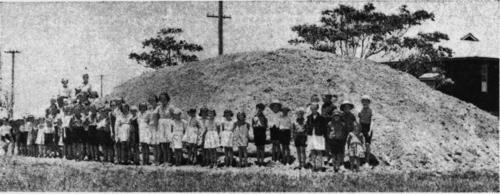
‘Children pictured in front of the Pinkenba School air raid shelter, December, 1940’ (Source: John Oxley Library, State Library of Queensland, image number 186886)
References
-
Truth, 23 May 1926 p11
-
Brisbane City Council, aerial photographs, 1946, 1995-2012
-
Brisbane City Council Properties on the Web
-
Department of Environment and Heritage Protection, Place Report: Pinkenba State School
-
National Library of Australia, Trove newspapers, Brisbane Courier, Courier Mail, Truth, Telegraph, The Week
-
Munro, Jennifer, Fighting Turtles: The life and times of the children who have attended Pinkenba State School No. 200 across three centuries between 1875-2001, Pinkenba: Pinkenba State School, 2002
-
Queensland Government Gazettes, via Text Queensland
-
Quest Newspapers, Northside Chronicle, 2008
Citation prepared by — Brisbane City Council (page revised September 2020)
